1. Nakeeb A, Pitt HA, Sohn TA, Coleman J, Abrams RA, Piantadosi S, et al. Cholangiocarcinoma. A spectrum of intrahepatic, perihilar, and distal tumors. Ann Surg. 1996; 224:463–473. discussion 473-475. PMID:
8857851.
2. Paik WH, Park YS, Hwang JH, Lee SH, Yoon CJ, Kang SG, et al. Palliative treatment with self-expandable metallic stents in patients with advanced type III or IV hilar cholangiocarcinoma: a percutaneous versus endoscopic approach. Gastrointest Endosc. 2009; 69:55–62. PMID:
18657806.

3. Glättli A, Stain SC, Baer HU, Schweizer W, Triller J, Blumgart LH. Unresectable malignant biliary obstruction: treatment by self-expandable biliary endoprostheses. HPB Surg. 1993; 6:175–184. PMID:
7683908.

4. Bae JI, Park AW, Choi SJ, Kim HP, Lee SJ, Park YM, et al. Crisscross-configured dual stent placement for trisectoral drainage in patients with advanced biliary hilar malignancies. J Vasc Interv Radiol. 2008; 19:1614–1619. PMID:
18823794.

5. Veal DR, Lee AY, Kerlan RK Jr, Gordon RL, Fidelman N. Outcomes of metallic biliary stent insertion in patients with malignant bilobar obstruction. J Vasc Interv Radiol. 2013; 24:1003–1010. PMID:
23796087.

6. van Delden OM, Laméris JS. Percutaneous drainage and stenting for palliation of malignant bile duct obstruction. Eur Radiol. 2008; 18:448–456. PMID:
17960388.

7. Yi R, Gwon DI, Ko GY, Yoon HK, Kim JH, Shin JH, et al. Percutaneous unilateral placement of biliary covered metallic stent in patients with malignant hilar biliary obstruction and contralateral portal vein occlusion. Acta Radiol. 2012; 53:742–749. PMID:
22850575.

8. De Palma GD, Pezzullo A, Rega M, Persico M, Patrone F, Mastantuono L, et al. Unilateral placement of metallic stents for malignant hilar obstruction: a prospective study. Gastrointest Endosc. 2003; 58:50–53. PMID:
12838220.

9. Gwon DI, Ko GY, Sung KB, Yoon HK, Shin JH, Hyoung Kim J, et al. Percutaneous biliary metallic stent placement in patients with unilobar portal vein occlusion caused by advanced hilar malignancy: outcome of unilateral versus bilateral stenting. AJR Am J Roentgenol. 2011; 197:795–801. PMID:
21940566.

10. Chang WH, Kortan P, Haber GB. Outcome in patients with bifurcation tumors who undergo unilateral versus bilateral hepatic duct drainage. Gastrointest Endosc. 1998; 47:354–362. PMID:
9609426.

11. Hsieh J, Thosani A, Grunwald M, Nagula S, Bucobo JC, Buscaglia JM. Serial insertion of bilateral uncovered metal stents for malignant hilar obstruction using an 8 Fr biliary system: a case series of 17 consecutive patients. Hepatobiliary Surg Nutr. 2015; 4:348–353. PMID:
26605283.
12. De Palma GD, Galloro G, Siciliano S, Iovino P, Catanzano C. Unilateral versus bilateral endoscopic hepatic duct drainage in patients with malignant hilar biliary obstruction: results of a prospective, randomized, and controlled study. Gastrointest Endosc. 2001; 53:547–553. PMID:
11323577.

13. Schoder M, Rossi P, Uflacker R, Bezzi M, Stadler A, Funovics MA, et al. Malignant biliary obstruction: treatment with ePTFE-FEP- covered endoprostheses initial technical and clinical experiences in a multicenter trial. Radiology. 2002; 225:35–42. PMID:
12354981.
14. Gwon DI, Ko GY, Yoon HK, Kim YJ, Kim TH, Lee WH, et al. Safety and efficacy of percutaneous Y-configured covered stent placement for malignant hilar biliary obstruction: a prospective, pilot study. J Vasc Interv Radiol. 2012; 23:528–534. PMID:
22341884.

15. Hyun H, Choi SY, Kim KA, Ko SB. Safety and efficacy of percutaneous biliary covered stent placement in patients with malignant biliary hilar obstruction; correlation with liver function. Cardiovasc Intervent Radiol. 2016; 39:1298–1305. PMID:
27224987.

16. Sacks D, McClenny TE, Cardella JF, Lewis CA. Society of Interventional Radiology clinical practice guidelines. J Vasc Interv Radiol. 2003; 14(9 Pt 2):S199–S202. PMID:
14514818.

17. Inal M, Akgül E, Aksungur E, Seydaoğlu G. Percutaneous placement of biliary metallic stents in patients with malignant hilar obstruction: unilobar versus bilobar drainage. J Vasc Interv Radiol. 2003; 14:1409–1416. PMID:
14605106.

18. Son RC, Gwon DI, Ko HK, Kim JW, Ko GY. Percutaneous unilateral biliary metallic stent placement in patients with malignant obstruction of the biliary hila and contralateral portal vein steno-occlusion. Korean J Radiol. 2015; 16:586–592. PMID:
25995688.

19. Ichikawa H, Yamanaka K, Tobe T, Mizumoto R. Bile secretion in regenerating liver--a comparison of hepatic resection and ligation of the portal vein branch in dogs. Gastroenterol Jpn. 1984; 19:320–327. PMID:
6489692.

20. Hadjis NS, Adam A, Gibson R, Blenkharn JI, Benjamin IS, Blumgart LH. Nonoperative approach to hilar cancer determined by the atrophy-hypertrophy complex. Am J Surg. 1989; 157:395–399. PMID:
2539024.

21. Gwon DI, Ko GY, Kim JH, Shin JH, Kim KA, Yoon HK, et al. Percutaneous bilateral metallic stent placement using a stentin-stent deployment technique in patients with malignant hilar biliary obstruction. AJR Am J Roentgenol. 2013; 200:909–914. PMID:
23521469.

22. Kim CW, Park AW, Won JW, Kim S, Lee JW, Lee SH. T-configured dual stent placement in malignant biliary hilar duct obstructions with a newly designed stent. J Vasc Interv Radiol. 2004; 15:713–717. PMID:
15231885.

23. Gwon DI, Ko GY, Yoon HK, Kim JH, Lee JM, Ohm JY, et al. Prospective evaluation of a newly designed T-configured stent graft system for palliative treatment of advanced hilar malignant biliary obstructions. J Vasc Interv Radiol. 2010; 21:1410–1418. PMID:
20800780.

24. Gwon DI, Ko GY, Kim JH, Yoon HK, Lee IS, Kim KA, et al. A comparative analysis of PTFE-covered and uncovered stents for palliative treatment of malignant extrahepatic biliary obstruction. AJR Am J Roentgenol. 2010; 195:W463–W469. PMID:
21098180.

25. Li M, Li K, Qi X, Wu W, Zheng L, He C, et al. Percutaneous transhepatic biliary stent implantation for obstructive jaundice of perihilar cholangiocarcinoma: a prospective study on predictors of stent patency and survival in 92 patients. J Vasc Interv Radiol. 2016; 27:1047–1055.e2. PMID:
27241392.

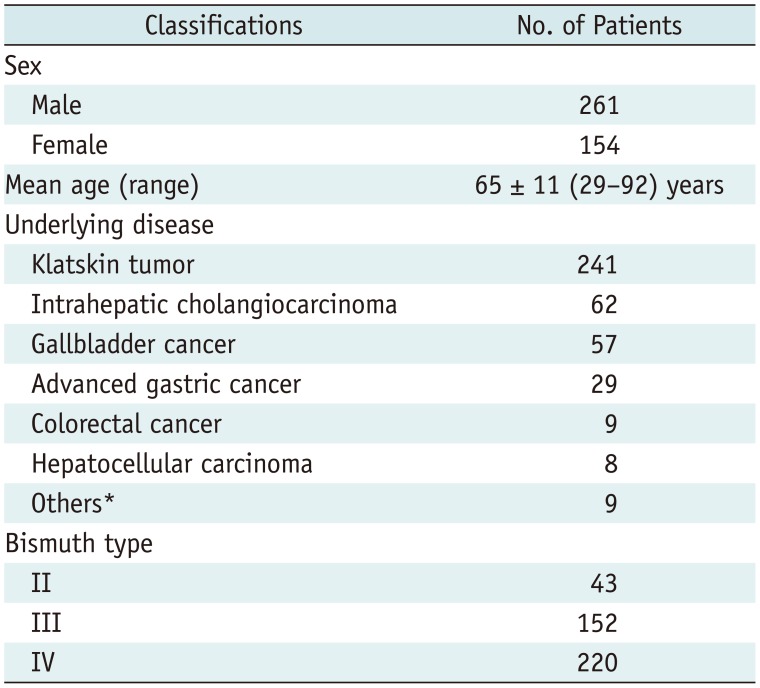

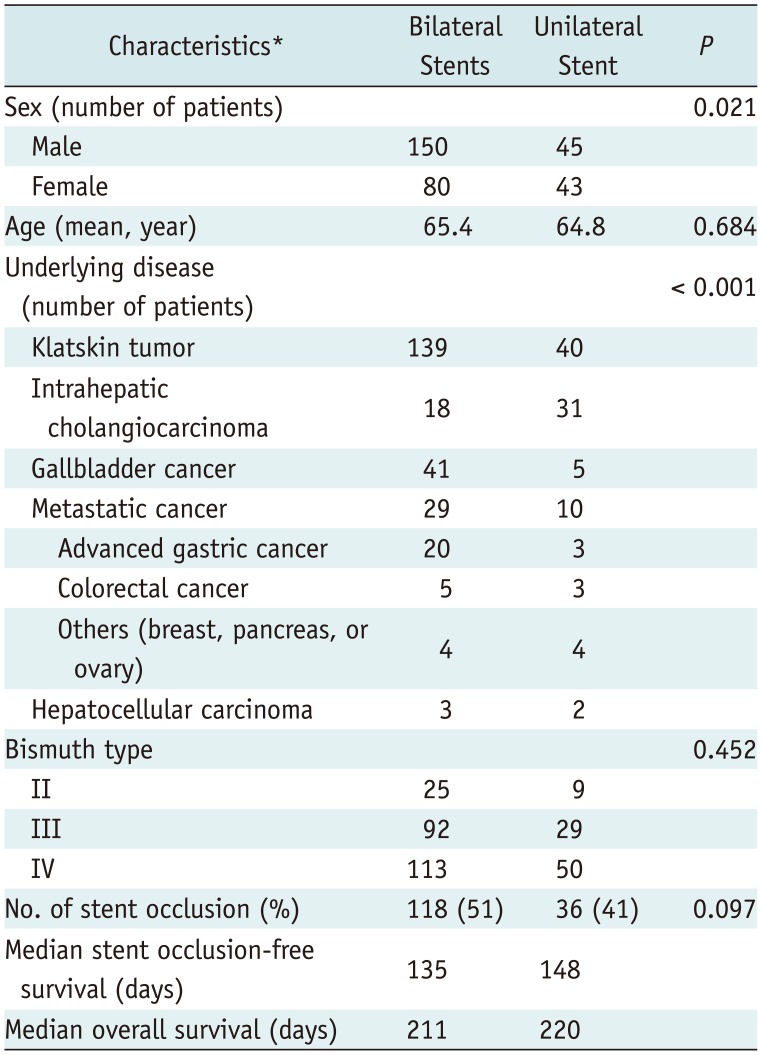
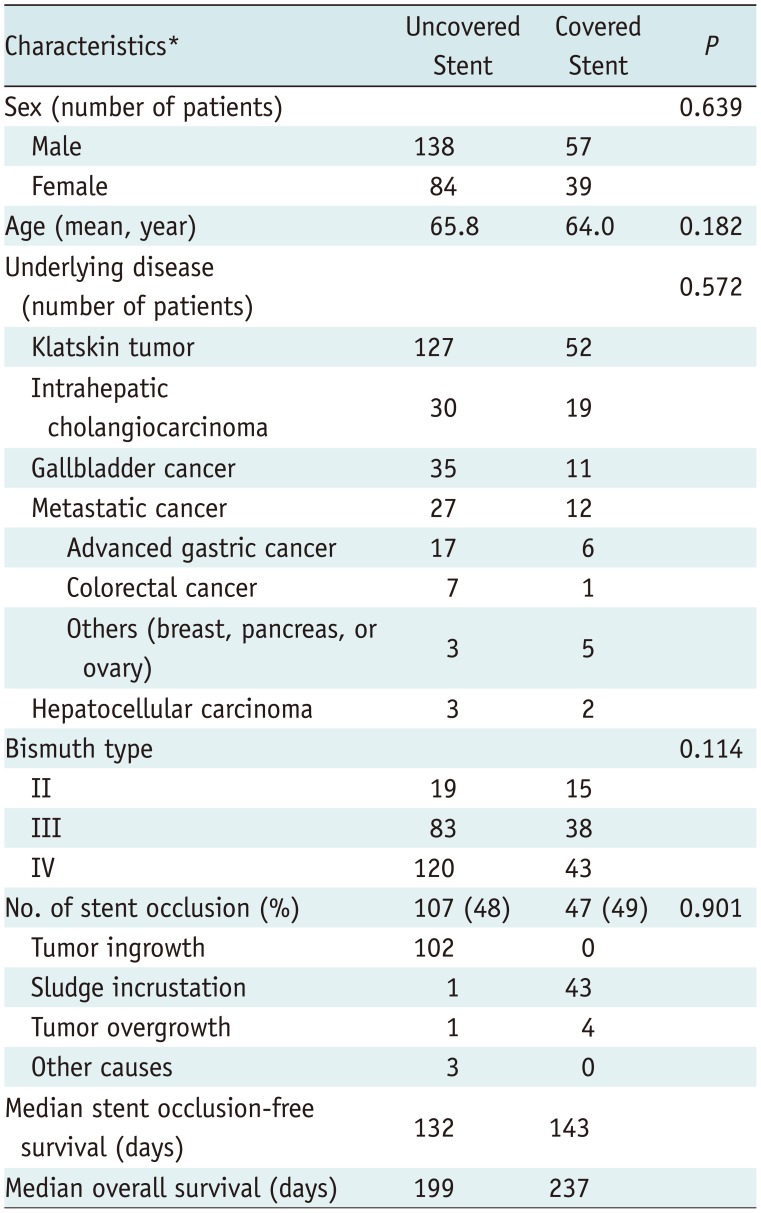
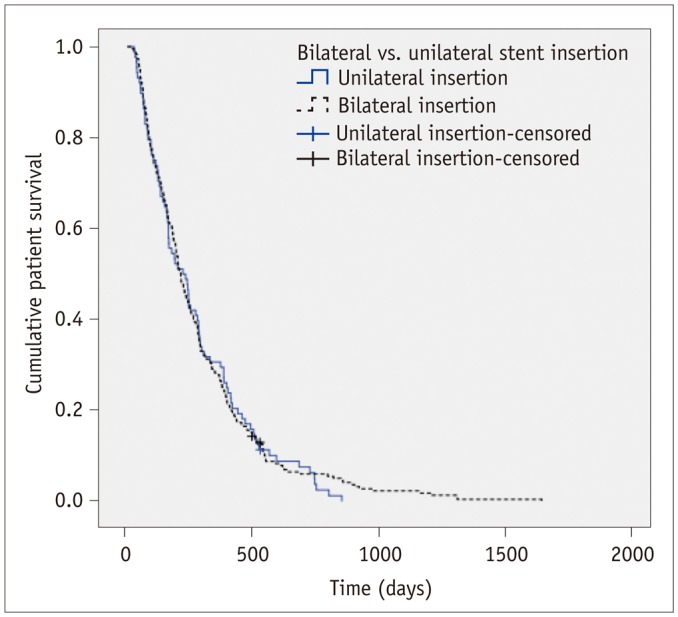
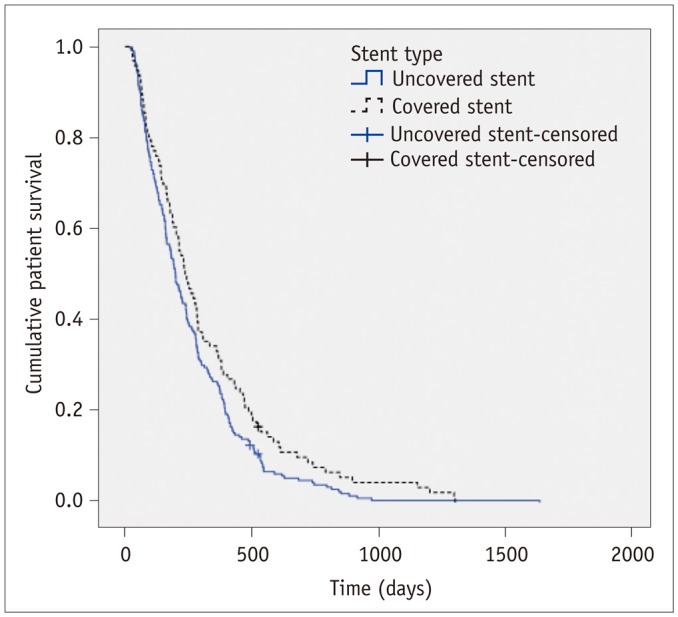




 PDF
PDF ePub
ePub Citation
Citation Print
Print


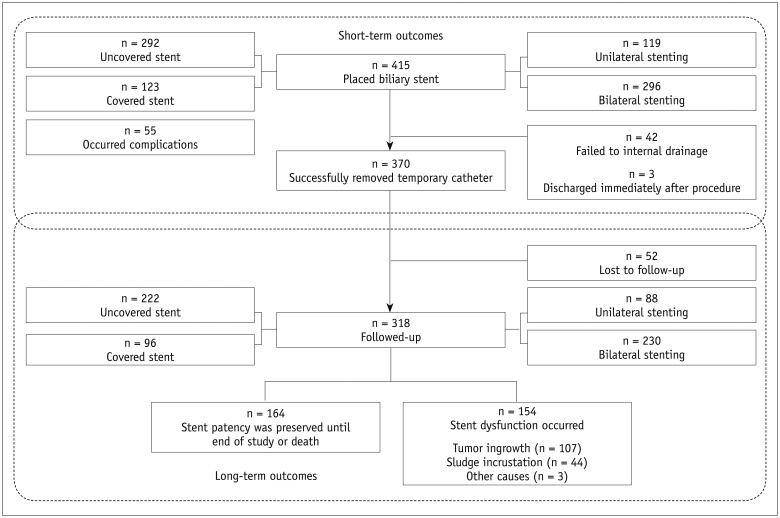
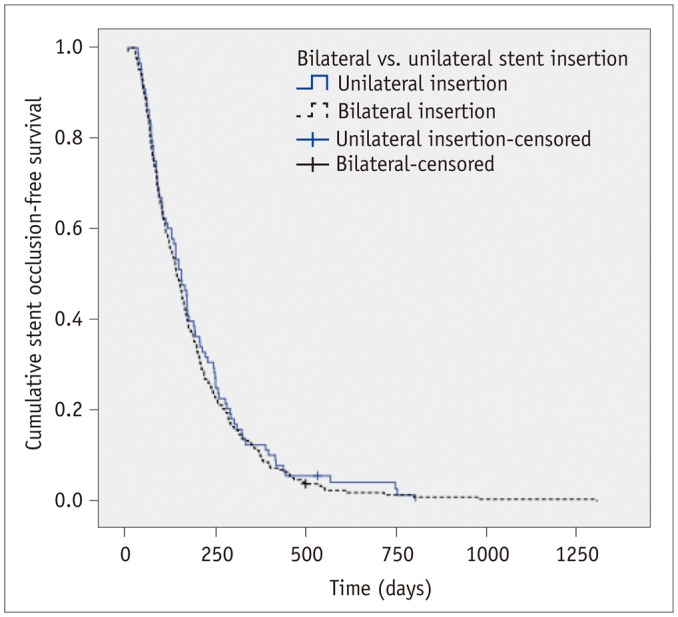
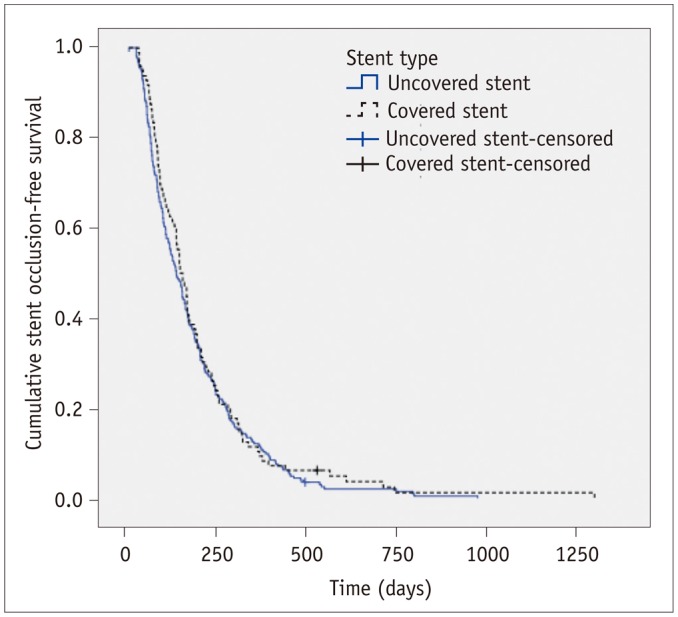
 XML Download
XML Download